2018 KIA K900 tires
[x] Cancel search: tiresPage 471 of 544
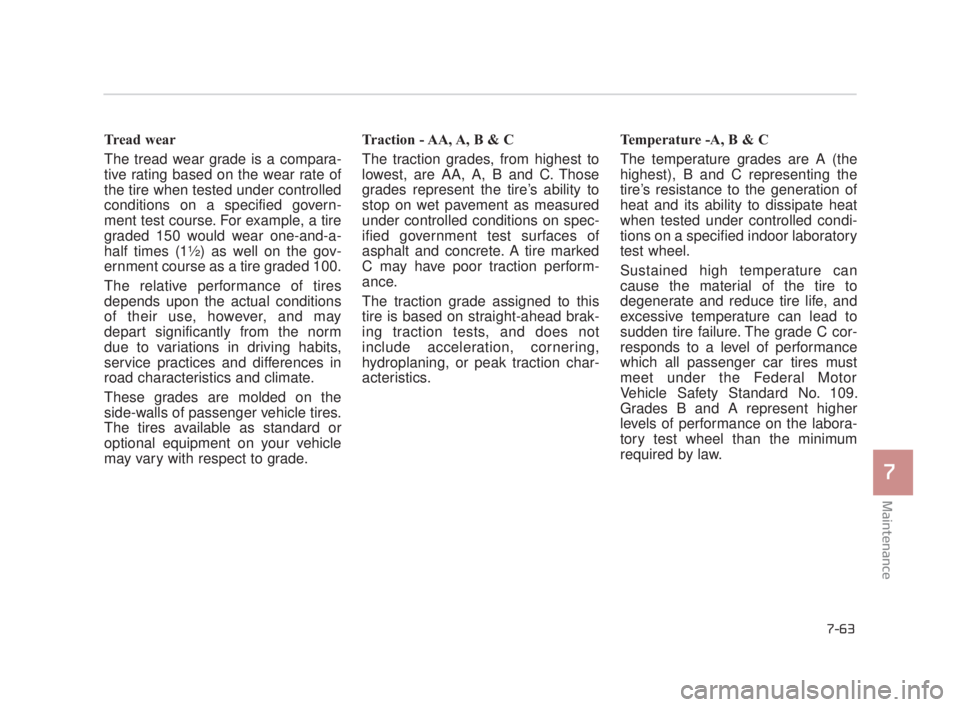
Maintenance
7
7-63
Tread wear
The tread wear grade is a compara-
tive rating based on the wear rate of
the tire when tested under controlled
conditions on a specified govern-
ment test course. For example, a tire
graded 150 would wear one-and-a-
half times (1½) as well on the gov-
ernment course as a tire graded 100.
The relative performance of tires
depends upon the actual conditions
of their use, however, and may
depart significantly from the norm
due to variations in driving habits,
service practices and differences in
road characteristics and climate.
These grades are molded on the
side-walls of passenger vehicle tires.
The tires available as standard or
optional equipment on your vehicle
may vary with respect to grade. Traction - AA, A, B & C
The traction grades, from highest to
lowest, are AA, A, B and C. Those
grades represent the tire’s ability to
stop on wet pavement as measured
under controlled conditions on spec-
ified government test surfaces of
asphalt and concrete. A tire marked
C may have poor traction perform-
ance.
The traction grade assigned to this
tire is based on straight-ahead brak-
ing traction tests, and does not
include acceleration, cornering,
hydroplaning, or peak traction char-
acteristics.
Temperature -A, B & C
The temperature grades are A (the
highest), B and C representing the
tire’s resistance to the generation of
heat and its ability to dissipate heat
when tested under controlled condi-
tions on a specified indoor laboratory
test wheel.
Sustained high temperature can
cause the material of the tire to
degenerate and reduce tire life, and
excessive temperature can lead to
sudden tire failure. The grade C cor-
responds to a level of performance
which all passenger car tires must
meet under the Federal Motor
Vehicle Safety Standard No. 109.
Grades B and A represent higher
levels of performance on the labora-
tory test wheel than the minimum
required by law.
KH USA 7:2018 4/14/2017 6:39 PM Page 63
Page 472 of 544
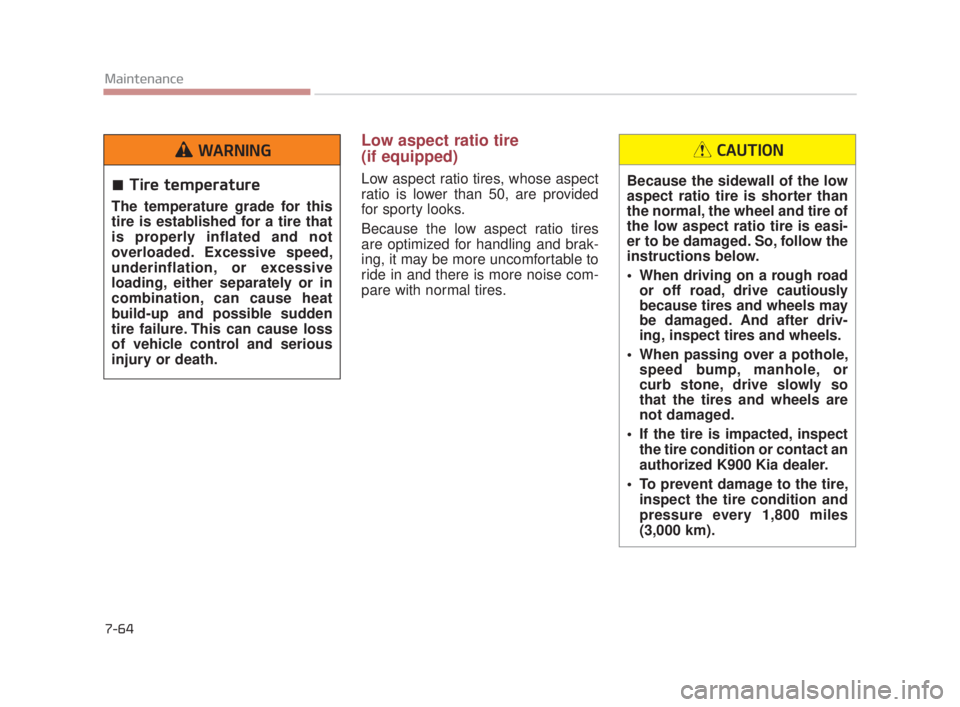
7-64
Maintenance
Low aspect ratio tire
(if equipped)
Low aspect ratio tires, whose aspect
ratio is lower than 50, are provided
for sporty looks.
Because the low aspect ratio tires
are optimized for handling and brak-
ing, it may be more uncomfortable to
ride in and there is more noise com-
pare with normal tires.Tire temperature
The temperature grade for this
tire is established for a tire that
is properly inflated and not
overloaded. Excessive speed,
underinflation, or excessive
loading, either separately or in
combination, can cause heat
build-up and possible sudden
tire failure. This can cause loss
of vehicle control and serious
injury or death.
WARNING
Because the sidewall of the low
aspect ratio tire is shorter than
the normal, the wheel and tire of
the low aspect ratio tire is easi-
er to be damaged. So, follow the
instructions below.
When driving on a rough roador off road, drive cautiously
because tires and wheels may
be damaged. And after driv-
ing, inspect tires and wheels.
When passing over a pothole, speed bump, manhole, or
curb stone, drive slowly so
that the tires and wheels are
not damaged.
If the tire is impacted, inspect the tire condition or contact an
authorized K900 Kia dealer.
To prevent damage to the tire, inspect the tire condition and
pressure every 1,800 miles
(3,000 km).
CAUTION
KH USA 7:2018 4/14/2017 6:39 PM Page 64
Page 475 of 544
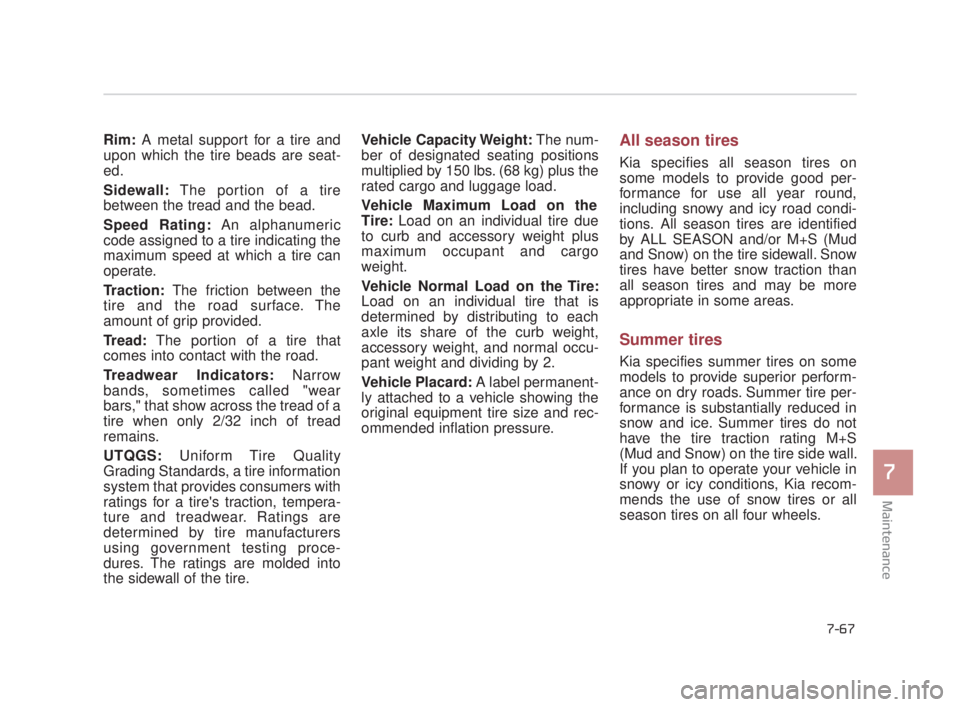
Maintenance
7
7-67
Rim:A metal support for a tire and
upon which the tire beads are seat-
ed.
Sidewall: The portion of a tire
between the tread and the bead.
Speed Rating: An alphanumeric
code assigned to a tire indicating the
maximum speed at which a tire can
operate.
Traction: The friction between the
tire and the road surface. The
amount of grip provided.
Tread: The portion of a tire that
comes into contact with the road.
Treadwear Indicators: Narrow
bands, sometimes called "wear
bars," that show across the tread of a
tire when only 2/32 inch of tread
remains.
UTQGS: Uniform Tire Quality
Grading Standards, a tire information
system that provides consumers with
ratings for a tire's traction, tempera-
ture and treadwear. Ratings are
determined by tire manufacturers
using government testing proce-
dures. The ratings are molded into
the sidewall of the tire. Vehicle Capacity Weight:
The num-
ber of designated seating positions
multiplied by 150 lbs. (68 kg) plus the
rated cargo and luggage load.
Vehicle Maximum Load on the
Tire: Load on an individual tire due
to curb and accessory weight plus
maximum occupant and cargo
weight.
Vehicle Normal Load on the Tire:
Load on an individual tire that is
determined by distributing to each
axle its share of the curb weight,
accessory weight, and normal occu-
pant weight and dividing by 2.
Vehicle Placard: A label permanent-
ly attached to a vehicle showing the
original equipment tire size and rec-
ommended inflation pressure.All season tires
Kia specifies all season tires on
some models to provide good per-
formance for use all year round,
including snowy and icy road condi-
tions. All season tires are identified
by ALL SEASON and/or M+S (Mud
and Snow) on the tire sidewall. Snow
tires have better snow traction than
all season tires and may be more
appropriate in some areas.
Summer tires
Kia specifies summer tires on some
models to provide superior perform-
ance on dry roads. Summer tire per-
formance is substantially reduced in
snow and ice. Summer tires do not
have the tire traction rating M+S
(Mud and Snow) on the tire side wall.
If you plan to operate your vehicle in
snowy or icy conditions, Kia recom-
mends the use of snow tires or all
season tires on all four wheels.
KH USA 7:2018 4/14/2017 6:39 PM Page 67
Page 476 of 544
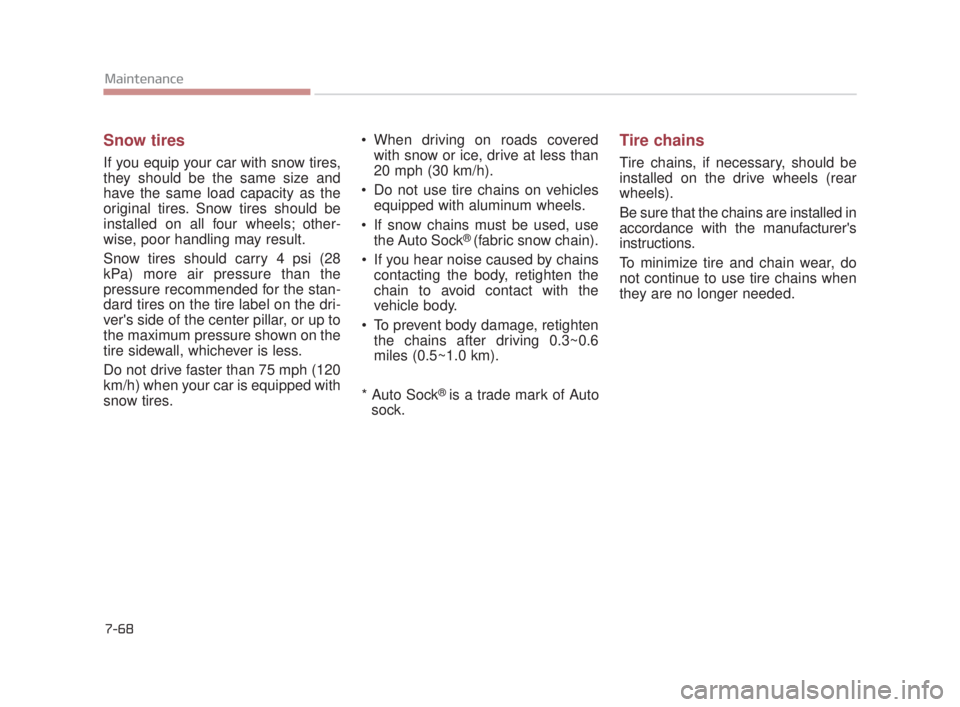
7-68
Maintenance
Snow tires
If you equip your car with snow tires,
they should be the same size and
have the same load capacity as the
original tires. Snow tires should be
installed on all four wheels; other-
wise, poor handling may result.
Snow tires should carry 4 psi (28
kPa) more air pressure than the
pressure recommended for the stan-
dard tires on the tire label on the dri-
ver's side of the center pillar, or up to
the maximum pressure shown on the
tire sidewall, whichever is less.
Do not drive faster than 75 mph (120
km/h) when your car is equipped with
snow tires. When driving on roads covered
with snow or ice, drive at less than
20 mph (30 km/h).
Do not use tire chains on vehicles equipped with aluminum wheels.
If snow chains must be used, use the Auto Sock
® (fabric snow chain).
If you hear noise caused by chains contacting the body, retighten the
chain to avoid contact with the
vehicle body.
To prevent body damage, retighten the chains after driving 0.3~0.6
miles (0.5~1.0 km).
* Auto Sock
® is a trade mark of Auto
sock.
Tire chains
Tire chains, if necessary, should be
installed on the drive wheels (rear
wheels).
Be sure that the chains are installed in
accordance with the manufacturer's
instructions.
To minimize tire and chain wear, do
not continue to use tire chains when
they are no longer needed.
KH USA 7:2018 4/14/2017 6:39 PM Page 68
Page 477 of 544
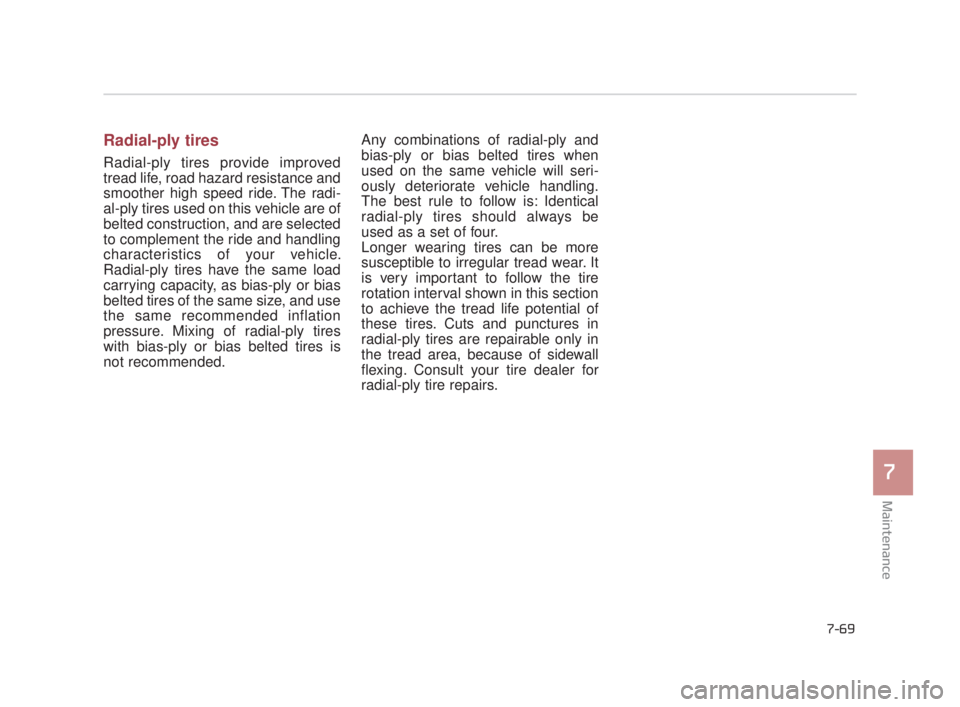
Radial-ply tires
Radial-ply tires provide improved
tread life, road hazard resistance and
smoother high speed ride. The radi-
al-ply tires used on this vehicle are of
belted construction, and are selected
to complement the ride and handling
characteristics of your vehicle.
Radial-ply tires have the same load
carrying capacity, as bias-ply or bias
belted tires of the same size, and use
the same recommended inflation
pressure. Mixing of radial-ply tires
with bias-ply or bias belted tires is
not recommended. Any combinations of radial-ply and
bias-ply or bias belted tires when
used on the same vehicle will seri-
ously deteriorate vehicle handling.
The best rule to follow is: Identical
radial-ply tires should always be
used as a set of four.
Longer wearing tires can be more
susceptible to irregular tread wear. It
is very important to follow the tire
rotation interval shown in this section
to achieve the tread life potential of
these tires. Cuts and punctures in
radial-ply tires are repairable only in
the tread area, because of sidewall
flexing. Consult your tire dealer for
radial-ply tire repairs.
Maintenance
7
7-69
KH USA 7:2018 4/14/2017 6:39 PM Page 69
Page 517 of 544
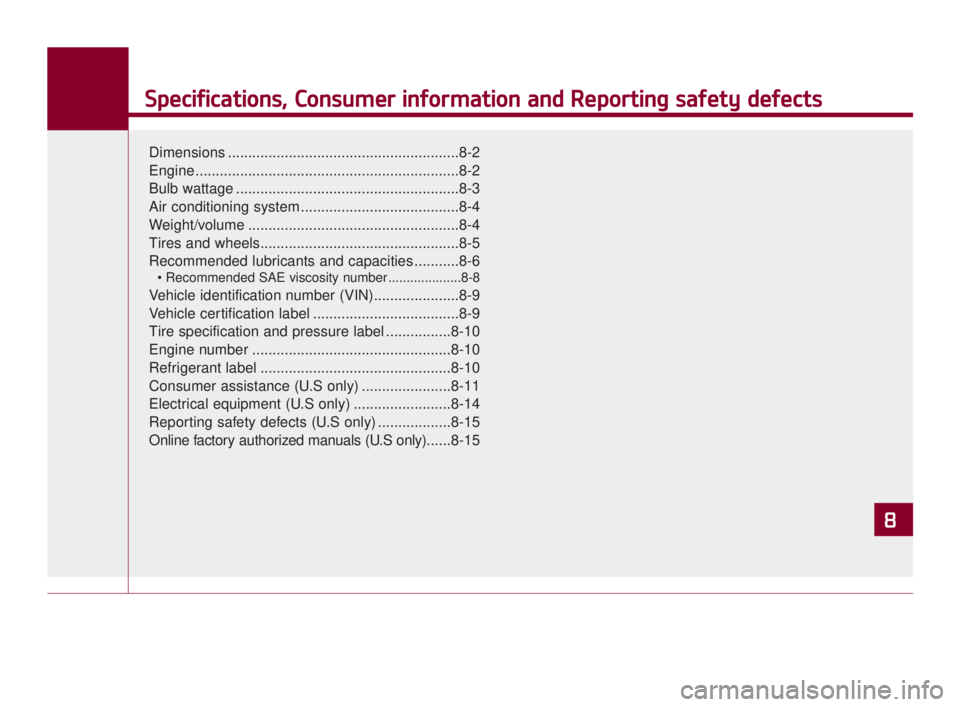
Specifications, Consumer information and Reporting safety defects
Dimensions .........................................................8-2
Engine .................................................................8-2
Bulb wattage .......................................................8-3
Air conditioning system .......................................8-4
Weight/volume ....................................................8-4
Tires and wheels.................................................8-5
Recommended lubricants and capacities ...........8-6
....................8-8
Vehicle identification number (VIN).....................8-9
Vehicle certification label ....................................8-9
Tire specification and pressure label ................8-10
Engine number .................................................8-10
Refrigerant label ...............................................8-10
Consumer assistance (U.S only) ......................8-11
Electrical equipment (U.S only) ........................8-14
Reporting safety defects (U.S only) ..................8-15
Online factory authorized manuals (U.S only)......8-15
8
KH USA 8:2018 4/14/2017 6:44 PM Page 1
Page 521 of 544
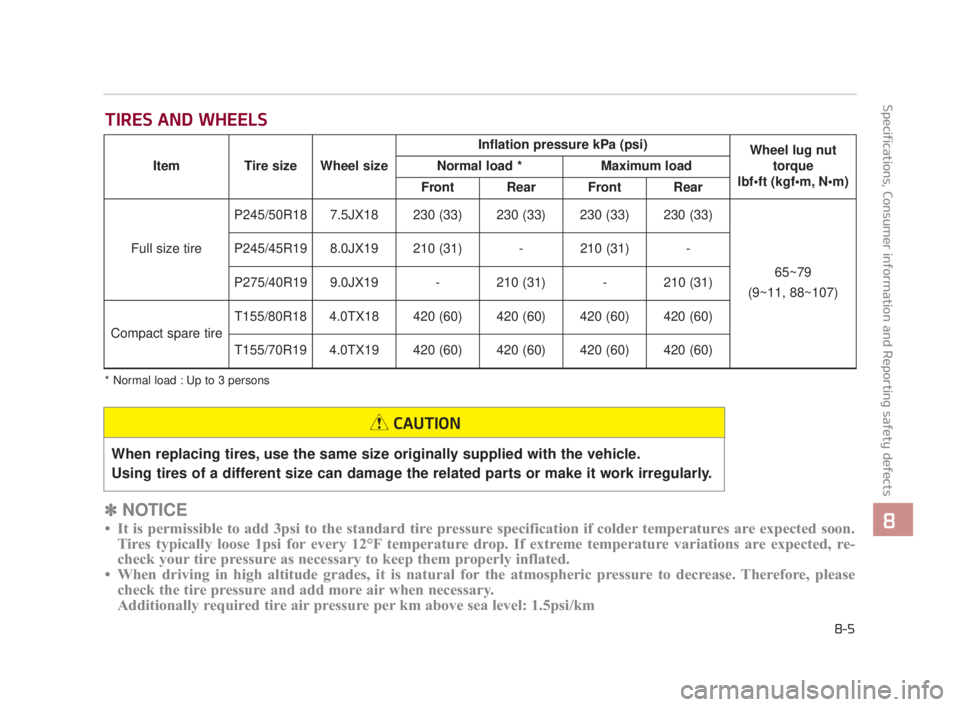
Specifications, Consumer information and Reporting safety defects
8
8-5
TIRES AND WHEELS
✽NOTICE
• It is permissible to add 3psi to the standard tire pressure specification if colder temperatures are expected soon.
Tires typically loose 1psi for every 12°F temperature drop. If extreme temperature variations are expected, re-
check your tire pressure as necessary to keep them properly inflated.
• When driving in high altitude grades, it is natural for the atmospheric pressure to decrease. Therefore, please check the tire pressure and add more air when necessary.
Additionally required tire air pressure per km above sea level: 1.5psi/km
* Normal load : Up to 3 persons
Item Tire size Wheel size Inflation pressure kPa (psi)
Wheel lug nut
torque
Normal load *
Maximum load
Front Rear Front Rear
Full size tire
P245/50R187.5JX18230 (33)230 (33)230 (33)230 (33)
65~79
(9~11, 88~107)
P245/45R19 8.0JX19 210 (31) - 210 (31) -
P275/40R19 9.0JX19 - 210 (31) - 210 (31)
Compact spare tire
T155/80R184.0TX18420 (60)420 (60)420 (60)420 (60)
T155/70R194.0TX19420 (60)420 (60)420 (60)420 (60)
When replacing tires, use the same size originally supplied with the vehicle.
Using tires of a different size can damage the related parts or make it work irregularly.
CAUTION
KH USA 8:2018 4/14/2017 6:44 PM Page 5
Page 526 of 544
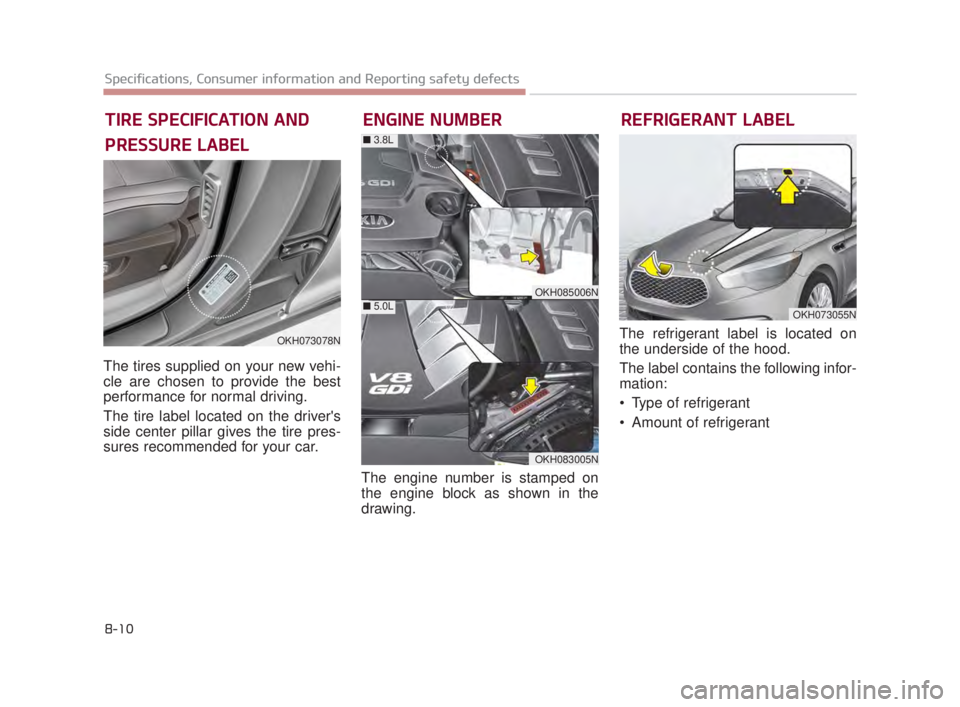
8-10
Specifications, Consumer information and Reporting safety defects
The tires supplied on your new vehi-
cle are chosen to provide the best
performance for normal driving.
The tire label located on the driver's
side center pillar gives the tire pres-
sures recommended for your car. The engine number is stamped on
the engine block as shown in the
drawing.The refrigerant label is located on
the underside of the hood.
The label contains the following infor-
mation:
Type of refrigerant
Amount of refrigerant
TIRE SPECIFICATION AND
PRESSURE LABEL
ENGINE NUMBER REFRIGERANT LABEL
OKH073055N
OKH073078N
OKH085006N
OKH083005N
■
3.8L
■ 5.0L
KH USA 8:2018 4/14/2017 6:44 PM Page 10